Over the weekend, Dr. Tom Frieden, former director of the Centers for Disease Control and Prevention (CDC), delivered the Saturday Essay in the Wall Street Journal. If you had any illusions that public health officials were in a contemplative mood, perhaps chastened by the last three years, newly capable of learning or showing even a hint of humility – think again. It’s difficult to cram so much bad pandemic analysis into 2,200 words.
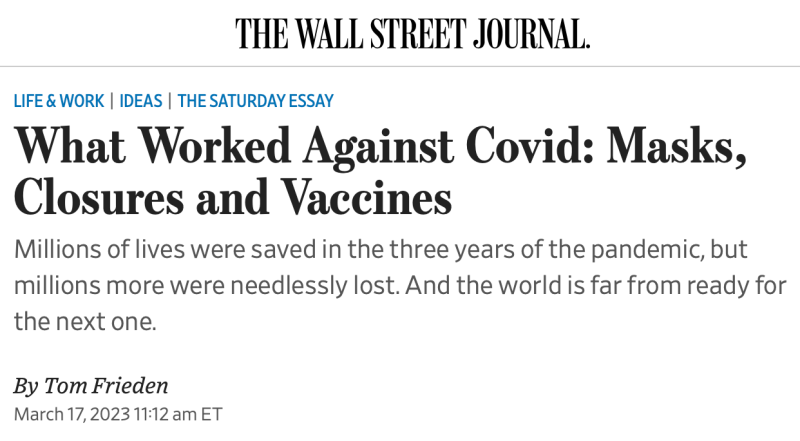
If you’ve read other odes to military-style Chinese pandemic management, you understand the sand-through-your-fingertips argument. The pandemic was so devastating that we lost 20 million lives. Masks, lockdowns, and vaccines, however, were so effective we saved tens of millions of lives. And if we’d only masked, vaccinated, and locked down harder, with a more war-time mentality, we could have saved most of the 20 million we did lose.
The argument presumes the supreme effectiveness of every measure and works backward to grade its own work. Heads we win. Tails you lose.
Frieden is correct that “the most accurate way to assess deaths from the pandemic is to estimate ’excess mortality’ — the increase of deaths over the historical baseline.” This avoids the tricky task of classifying cause of death. Plus, it captures the totality of pandemic policies, for good and ill. Or at least a sound analysis would.
Frieden cites an estimate of 20 million excess deaths worldwide, but then spends the rest of the article playing number games. He implies but doesn’t say these are all Covid deaths. He fails to grapple with the leading edge data and science and forgets to add up the intervention costs, including the reality that some of those costs are excess deaths. He doesn’t attempt to explain how so many people died of non-Covid causes, including brand new studies showing a spike in maternal mortality. He also fails to address non-mortality effects such as the economy, addiction, mental health, and falling birth rates.
What About Sweden?
Frieden says all the intrusive mandates limited deaths, especially in Canada and Israel, which he says skillfully “used masking and selective closures (based on accurate, real-time data) just before a wave hit.” But he doesn’t mention that Sweden’s conspicuous refusal to close up shop or force masking resulted in the very lowest excess mortality in Europe. In other words, Sweden didn’t do the things Frieden lauds yet achieved the best results.
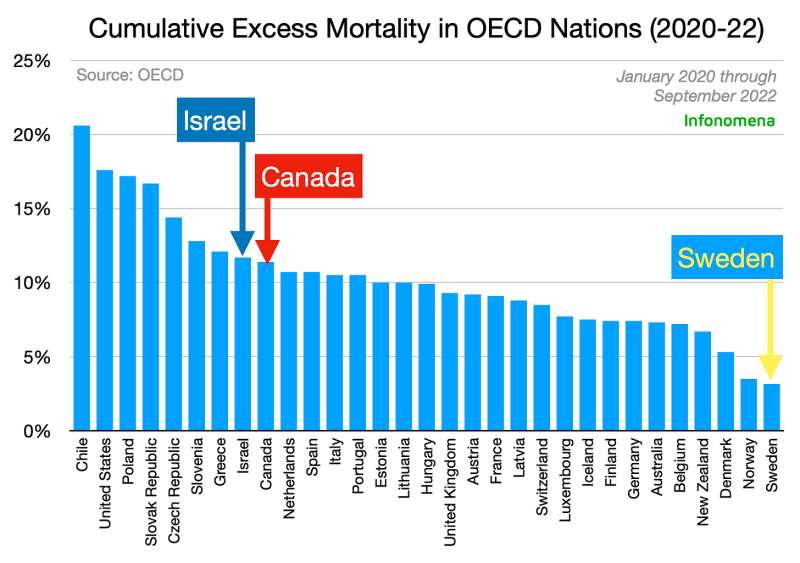
Yes, Sweden enjoys favorable demographics and health. Yet it outperformed its Nordic neighbors with similar profiles. Looking across nations, economists at Johns Hopkins found little or no relationship between lockdown strength and Covid mortality. Even if one conceded that masks and lockdowns have some tiny effects, it cannot be said they determine pandemic policy success.
The story within the United States shows the same lack of lockdown efficacy. Casey Mulligan and colleagues compared US states and found that “more severe lockdowns did not result in improved health outcomes. But the severity of government response was strongly correlated with both worse economic outcomes and worse overall outcome scores.” They also confirmed that “people left lockdown states and moved to states with less severe measures” and that California, a young state which imposed strict measures, and Florida, an older state which was more open, “had roughly equal health outcome scores.”
Frieden claims that “masks proved to be surprisingly effective.” Yet he doesn’t address the new Cochrane Review meta-analysis, the most thorough and authoritative analysis to date, which integrates 78 randomized control trials of mask usage. It found just the opposite – that masks showed no beneficial effect. Is it really that complicated? Everyone wore masks, and the virus spread everywhere. Just as respiratory viruses experts predicted pre-pandemic.
Inflated Benefits, Ignored Costs
Frieden’s audacious assertions of lockdown benefits are matched by his equally egregious failure to address their enormous costs. Frieden mentions forgone health care but doesn’t tie it to lockdowns. It just happened. He does criticize school closures but doesn’t include them in any cost-benefit analysis. He totally ignores lockdown effects on his own stated key metric of excess mortality.
Neither does Frieden mention the macroeconomic effects, which always impact health, if indirectly. After tens of trillions of dollars spent and printed in an effort to ‘replace’ lost production, we are left with the worst inflation in 40 years, subpar growth, a wobbly banking sector, and significantly reduced labor participation. These are not incidental downsides that can just be whisked away.
Frieden then deploys the big guns – assertions of lives saved so outrageously gigantic they can only be meant to stun readers into submission. He claims that
most of the 20 million deaths occurred among the three billion people who were never vaccinated. The first year of vaccination alone is estimated to have prevented more than 14 million deaths.
We’ve shown over and over how preposterous the second claim is. It’s based on yet another computer model from Imperial College London. The first claim is a less familiar formulation but nearly as silly.
A few general observations show why it’s so implausible. For one, all-cause excess deaths and Covid-19 deaths (see below) were highest in high and upper middle income nations with high vaccination rates and lowest in low income nations with low vaccination rates.
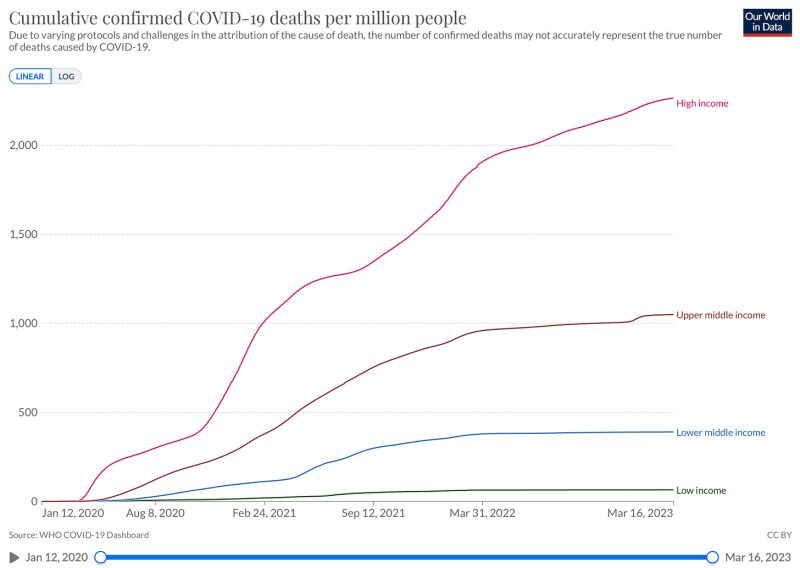
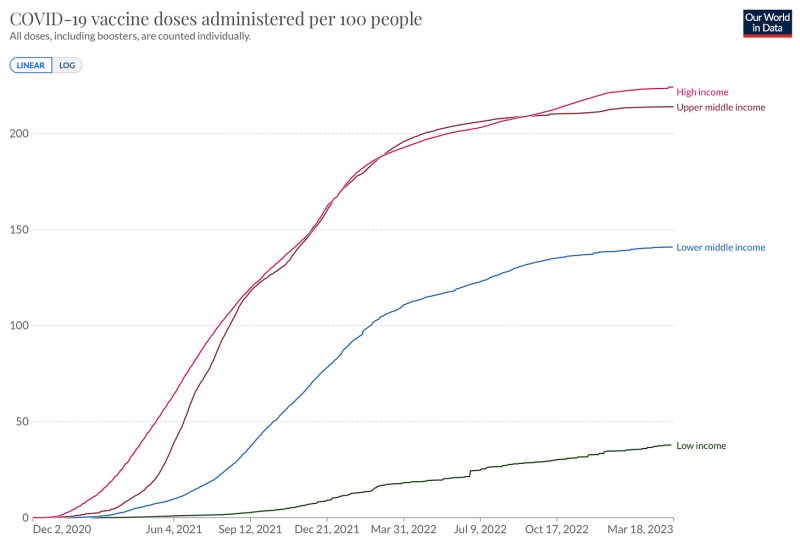
Is Frieden claiming that an astronomical portion of the small number of unvaccinated people in high income, highly vaccinated nations were dying but that almost none of the much larger number of unvaccinated people in low income, low vaccinated nations were?
Yes, high income, highly vaccinated nations tend to be older, and low income younger. But the mortality differential between high and low income nations is vastly greater than the age differential could generate, especially when accounting for vaccination status.
Zoom in on the United States. According to official data, the US suffered 350,555 Covid-19 deaths in 2020 and 475,059 in 2021.
1 Despite the administration of 520 million vaccine doses in 2021, Covid took 124,504 more American lives in 2021 than 2020. In other words, the pool of unvaccinated Americans shrank by around 250 million in 2021 but Covid deaths rose by 35 percent.
Or look at Scotland, which keeps somewhat better and more detailed data according to vaccination status. Between August 2021 and February 2022, at least 85 percent of Covid deaths were among the vaccinated. By late spring, the figure had surpassed 90 percent. Soon after we pointed this out, they stopped publishing such data.

The average age of Covid deaths in many nations is around 80, or close to the average age of all deaths. So clearly “most of the 20 million deaths” Frieden cites cannot be due to Covid mortality among the unvaccinated, if for no other reason than the vast majority of Covid deaths occur among the elderly, who happen to be highly vaccinated.
But that only leaves non-Covid deaths. Why would the unvaccinated be dying of non-Covid causes? They wouldn’t. At least not because they are unvaccinated.
We must also dispense with a seeming sleight of hand. Or maybe Frieden doesn’t realize what he did. Remember, “most of the 20 million deaths occurred among the three billion people who were never vaccinated.” Well, nearly all people worldwide until mid-2021 were unvaccinated. And most of the 20 million died of non-Covid causes. Is he counting all excess deaths in 2020 and part of 2021 – whether from Covid or lockdowns or whatever – as “unvaccinated” before a vaccine was even available? Seems like a non sequitur.
We’re not finished. For many nations, from Germany to Japan and Singapore to Australia, both all-cause deaths and Covid deaths only spiked after they deployed the vaccines. See below a new actuarial analysis of German data. It shows that all age cohorts survived 2020 rather well. Then in 2021 and 2022, as Germans received 191 million vaccine doses, mortality exploded among nearly all adult age groups.
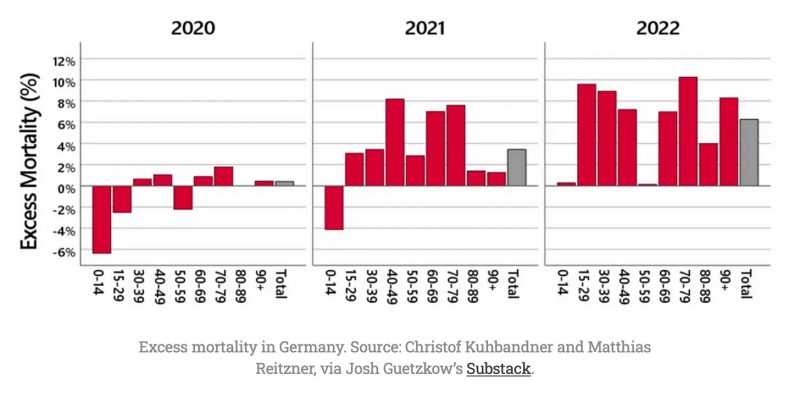
You can see this persistently high excess mortality pattern in highly vaccinated nations, even in Israel, one of Frieden’s favorites.
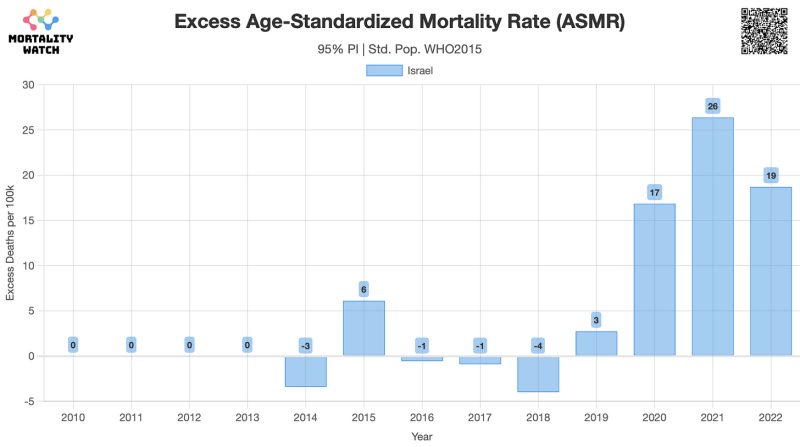
As we noted in a recent survey of global mortality, among high and middle income nations, all-cause excess deaths in 2022 were actually correlated with higher vaccination rates.
Model Mania
These facts add to an already iron-clad mathematical and biological certainty that the vaccines could not have saved “14 million lives” in the “first year of vaccination alone.” Frieden’s claim is based on a ridiculous computer model, which can output anything you like depending on the assumptions you feed it. It does not need to resemble anything in the real world, and indeed this one does not.
The models spit out crazy things. If you don’t double check them against reality, you can look wildly foolish. Both actual Covid and non-Covid mortality were far worse after the vaccines in 2021-22. In the computer model’s fantasy world, however, we were poised for an acceleration so super-galactic that the worse performance was actually a big win.
In December, we analyzed a model from the Commonwealth Fund, which is similar to the Imperial model Frieden cites. The Commonwealth modelers claim that in an alternate no-vaccine universe the US was going to suffer 4.5 times more Covid deaths in 2021 than in 2020, and fully 6.9 times more in 2022 when the milder Omicron variants dominated. Even before Omicron, a host of pre-vaccine studies found an overall infection fatality rate (IFR) of just 0.15-0.2 percent. So, the claim is that the vaccines “saved” tens of millions of hypothetical people from a fictional pandemic that suddenly got seven times worse. It’s a preposterous counterfactual daydream.
- The One Million Lives Saved Claim: Part 1
- Double Down Hallucination: Part 2
- Defending Steph Curry: A Computer Model: Part 4
- A Narrative That’s Too Big To Fail: Part 6

Frieden’s fantasies cover up something even worse. While he is touting the false effectiveness of masks, lockdowns, and vaccines – and wishing for more – he is ignoring a true crisis.
True Crisis
The bulk of evidence now points to vaccination as a key factor not in a mortality reduction but a historical increase.
One of Frieden’s biggest failures is to distinguish outcomes for different age groups. Deaths of 20-year-old students or 40-year-old mothers hit differently than 95-year-olds.
Frieden doesn’t acknowledge the crucial facts which are apparent in life insurance data and the more granular country reports: Young and middle-age healthy people all over the high and upper-middle income world navigated 2020 with relative success but then started dying at alarming rates in 2021 and 2022. They are dying mostly not of Covid. The crisis of sudden adult death syndrome (SADS) in particular and the non-elderly mortality rise in general cannot be blamed on too little masking, vaccinating, and locking down.
Instead of dashing to diagnose and douse this five-alarm mortality fire, Frieden is pushing for, you guessed it, more pandemic preparedness.
If we weren’t exhausted from unpacking the lockdown, mask, and vaccine misdirection, we would spend more time on Frieden’s spurious claims that anti-viral medications and hospital treatments were especially effective in combatting Covid. Surely, he must be joking. The US government led a war against safe, cheap, effective anti-virals (such as ivermectin and hydroxychloroquine) and insisted on a dangerous, experimental hospital “standard of care” called remdesivir. They’ve never been asked to explain how so many people died of Covid in the hospital if remdesivir were at all effective.
Call to Action
The failure of public health authorities to honestly appraise a series of historic failures shows why they were so ill-suited to the task. Perhaps they do not have the skills to analyze, execute, learn, and course correct. Or maybe the institutions – from the FDA and CDC to local and state health departments to medical schools – lack some kind of organizational fortitude or resistance to groupthink.
We’ve known for decades healthcare is broken economically. A silver lining of Covid is the realization that science and medicine are broken in even more fundamental ways and that we should triple our efforts to remake the entire enterprise.
Republished from the author’s Substack
Published under a Creative Commons Attribution 4.0 International License
For reprints, please set the canonical link back to the original Brownstone Institute Article and Author.









